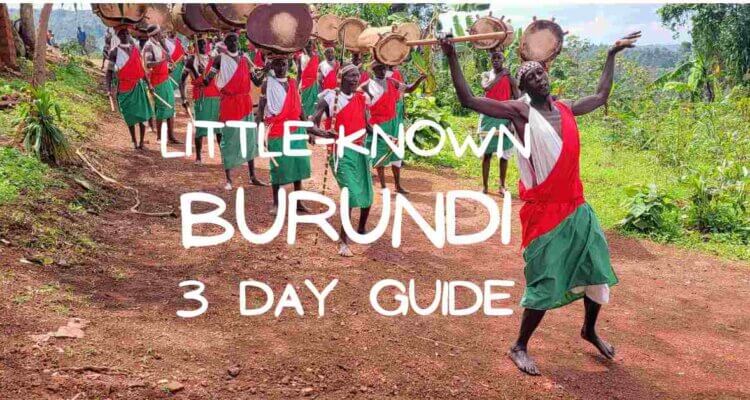Burundi is a small, landlocked country in the heart of Africa. It is bordered by Rwanda to the north, Tanzania to the east and south, and the Democratic Republic of the Congo to the west. This is a place with diverse landscapes; including mountains, lakes, and forests. The map of this country looks like a heart and is therefore known as the Heart of Africa.
Our goal was to visit when we last came to see the Mountain Gorillas in the Bwindi National Park in Uganda. However, the borders were closed due to the pandemic. So we just had to wait for this little-known country. And we are so glad that we did!
Getting to Burundi
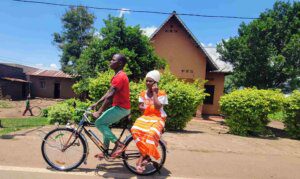
Bujumbura International Airport (BJM), is the main airport in the country. It is served by airlines including: Kenya Airways (Nairobi), RwandAir (Kigali), Ethiopian airlines (Addis Ababa), Brussels Airlines (Brussels), Uganda airlines (Entebbe). Air Tanzania Kigoma and Dar Es Salaam.
We were coming from Nosy Be, Madagascar and the only connection that we could find was through Addis Ababa. Knowing that there would be an overnight layover, we used 45K Aeroplan points each for Etihad metal and flew business. Why? Well, if you are flying business class through Addis Ababa, then you get a nights stay at the In Transit Addis Ababa hotel for free.
Funny story, as we were getting into the plane from Addis to Bujumbura, we noticed a sparkly well- dressed woman in 1A (right in front of our seats). Everyone was bowing to her as they entered the plane. The flight attendant quietly informed us that the lady was none other than the First Lady of Burundi. Upon landing, there was a parade on the tarmac waiting for her!
Visa on Arrival
Once we landed in the capital, everyone was falling over themselves to get to the First Lady. We high tailed it out of the plane as fast as we could to get to the Visa on Arrival window first. Because of all of the commotion, the back door got opened and some of the economy class folks got to the visa counter before us.
However, the process was quite seamless and we were out of there within 20 minutes. Our 3-day transit visa on arrival cost $41 USD each. The extra dollar was added for the use of a credit card.
PRO TIP: Prior to landing it is important to enter your travel information into this site here, to immediately receive your entry QR Code. In addition, the same site contains the exit form which also needs to be completed prior to leaving the country.
Guide
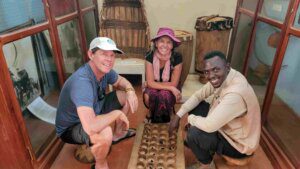
Given that we travel non-stop, and have been since 2017 full-time, we have met a lot of guides. And we have been lucky, the majority of them have been quite good. However, our guide Charles Bigirimana of Burundi Discovery Tours (What’s App +257 62 84 74 35) showed us the gold standard of guiding. He made sure that we were taken care of at every step of the way. Charles’ passion about the subject matter, his knowledge, enthusiasm, patience and kindness blew us away. We would highly recommend Charles for any trip in East and Central Africa.
Connectivity and SIM Cards
Lumitel prepaid sim cards are the ones that we recommend for Burundi. They have the most advanced 3G/4G network here and the packages are quite cheap. For $5 USD one can purchase 6 GB of data for 1 week. We highly recommend doing this as the hotel that we stayed in had very poor wifi.
Money
Currency here is the Burundian Franc, which at time of writing officially was valued at 2,845 BF to $1 USD. Since we had to pay for the hotel and our guide in cash, I was excited to find an ATM in the airport and quickly took out the maximum amount of Burundian Francs. This was not a good idea! Why? Well, no one wants this currency. The currency of choice here is the all mighty USD or Euro.
Our guide explained to us that most things of value are purchased on the black market (fuel for example). And to purchase these kinds of things one needs to use the USD. In addition, due to the shortage of foreign currency, the black market exchange for the USD is much higher than the official rate (at times double).
We do suggest taking out some Burundian Francs for food, souvenirs, small tips, etc., However, for all other payments, we suggest you bring US currency.
Safety
Let’s be clear, most governments have a statement on their websites to reconsider travel here. However, we felt safe in Burundi. Our guide made the trip feel incredible, safe and seamless.
Best time to Go
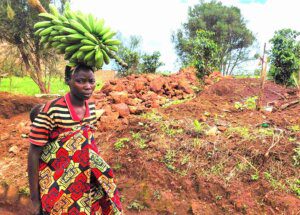
If you’re interested in trekking with chimpanzees in Kibira National Park, visit during the rainy seasons (mid-February to early June and mid-September to mid-December). This is when food is abundant and the chimpanzees are easier to find. In the dry season, chimpanzees move more often in search of food, making them more difficult to track.
If you’re interested in visiting other popular tourist attractions in Burundi, such as the Gishora Drum Sanctuary and museums, the dry season (June to August) is the best time to visit.
Accommodations
For us, it was difficult to book a hotel in Bujumbura. For one, the electronic entry form only has a limited list of hotels. Second, many of the hotels are not online and are very difficult to book. We stayed at the Goodlife Residence Hotel (as it was on the list for the online entry form). However, we cannot recommend this hotel for a variety of reasons including poor wifi and the scorpions that Rob had to kill nightly.
Here are the hotels that are better. Please keep in mind that none of these hotels are at the level of western standards that most of us expect.
- Hotel Club du Lac Tanganyika – a hotel on the beach of Lake Tanganyika. It is quite tired for the price, but does have the pretty lake to look at. $135 USD
- Botanika Hotel – this hotel is in the heart of Bujumbura and is clean. We have requested for it to be added to the online entry form list. $65 USD
- Safari Gate Hotel – hotel near Lake Tanganyika with a pool. $90 USD
Things to See & Do in Burundi
Gishora Drum Sanctuary

Nestled in the lush hills of Burundi, near the city of Gitega, is the Gishora Drum Sanctuary, a sacred place where the country’s rich drumming tradition is preserved and celebrated. The sanctuary is home to a collection of over 100 traditional Burundian drums, some of which are over 100 years old.
The Gishora Drum Sanctuary is a place where visitors can learn about the history and significance of Burundian drumming. They can also see the drums being played by master drummers. It is a show unlike any other. The drummers play their drums and perform a dance which is intoxicating. We felt quite emotional as did many of the others attending this performance. The beat of the music is powerful and emotive.
The Gishora Drum Sanctuary is a must-visit for anyone interested in Burundian culture and history. It is a place where the country’s rich drumming tradition is kept alive and thriving.
Kibira National Park
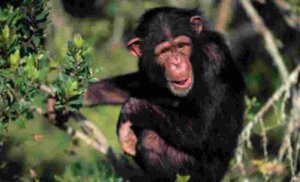
Kibira National Park is a 400-square-kilometer rain-forest in northwest Burundi. It is home to a large population of chimpanzees, and is a popular destination for chimpanzee trekking safaris. The park is also home to a variety of other primates, including the Angolan colobus, owl-faced monkey, and mountain monkey. The dense forest is rich in water and food sources, which attracts plenty of wildlife.
Kibira National Park is a beautiful place to visit, with its lush green mountains and tea plantations.
Busekera Batwa Village

The Batwa of Burundi are an indigenous people who have lived in the country’s forests for centuries. At times, they are called pygmies. However, they prefer to be referred to as the Batwa people (and better yet – Burundians). They are a vulnerable minority group, with a population of around 100,000.
The Batwa have traditionally been hunter-gatherers, but forest clearances and conservation efforts have forced them to move out of their ancestral homes and into mainstream Burundian society. One of the biggest challenges facing the Batwa is a lack of land. Many Batwa are now landless and forced to live in poverty. Unfortunately, they also face discrimination and marginalization from the wider Burundian society.
Meeting with these happy and lively Burundians was a big highlight of our trip. We were welcomed by the village elders with song and dance! I was asked to join in the festivities and really enjoyed trying to keep up with their rhythm and jubilance. We were shown around the village including the class room that the village had to teach the kids of the village.
If you choose to come to a Batwa village, may I recommend that you bring some writing supplies for the kids. They need everything from hygiene supplies to clothes to food. However, anything for learning may be even more valuable and lasting.
Lake Tanganyika

Lake Tanganyika is one of the Great Lakes of Africa, and is the second-deepest lake in the world after Lake Baikal in Siberia. It is also the longest freshwater lake in the world. It is shared by four countries: Burundi, the Democratic Republic of the Congo, Tanzania, and Zambia.
The lake looks and feels more like an ocean or a sea than a lake. There are numerous private beaches that one can visit for the day or stay in a hotel there. Wooden boats wait to take people on a ride on the lake.
Lake Tanganyika is also home to an incredibly diverse range of fish species. There are over 300 different species found here. This diversity is due to the lake’s long isolation from other bodies of water, which has allowed the fish to evolve in unique ways. Some of the most notable fish species found in Lake Tanganyika include the cichlids, which are known for their bright colors and intricate patterns.
Teze Tea Plantation

Burundi is famous for its fragrant tea! The Teze Tea Plantation is a gorgeous area to visit due to the mountain valley landscapes of the Kibira National Park framing the verdant plantations. Getting to the top of the farm and taking in the views is worth the drive up the rutted out road. In the past tea tastings were available. However they have not reopened since the pandemic.
Source of the Nile
In the lush mountains of Burundi, about 115 km southeast of Bujumbura, lies a tiny stream that is said to be the southernmost source of the Nile River. But is it really?
There are many different sources of the Nile, and it is difficult to say definitively which one is the true source. The Burundi source is one of the most likely contenders, but it is also possible that the Nile has multiple sources.
The Burundi source was discovered in 1937 by German explorer Burkhart Waldecker. Waldecker had come to Africa seeking asylum from Nazi persecution, and he soon became obsessed with finding the Nile’s source. It took him four years to trace the nearly 7,000 km between where the Nile empties into the Mediterranean and this source. To celebrate and commemorate his discovery, Waldecker built a stone pyramid. A bit tacky, but many tourists enjoy the story and the photo opportunity.
This source is just a tiny trickle of water flowing slowly down from a spring on Mount Kikizi. But it is a significant place, nonetheless. It is a reminder of the Nile’s long and mysterious history, and it is a testament to the human spirit of exploration.
Itinerary: 3 Days
3 Day Itinerary
Day 1: Pick up from airport and transfer to hotel. Do Bujumbura City tour and relax on Lake Tanganyika and it’s beaches.
Day 2: Drive north to visit the Teza Tea Plantation and it’s verdant hills. Then continue north to the Gishora Drum Sanctuary (Burundi Drummers). Have lunch at the Helena Hotel Restaurant in Gitega. Visit the Gitega National Museum. Visit the Busekera Batwa Village.
Day 3: Transfer to airport.
Option: If you would like to fit the Kibiri National Park into this 3 day itinerary, then on Day 2, spend the night in Gitega and visit Kibiri in the morning prior to heading back to the airport. Another option is to arrive early on Day 1 and transfer to Gitiga early. Bujumbura city tour can easily be missed.
Wrap Up

We truly enjoyed the Heart of Africa. It is a friendly country with beautiful mountains, verdant forests and stunning tea plantations. We felt safe here and Charles, our guide made the journey incredibly enjoyable. The Gishora Drum Sanctuary and Busekera Batwa Village visits were the highlights for our time here.
Have you been to the Heart of Africa or are you planning on going? We would love to hear about your experience here. Let us know in the comments.

